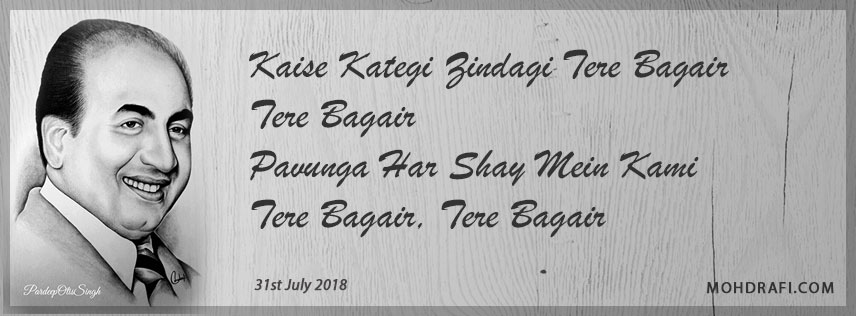The King Of Melody
This article is by Ajay Chaturvedi.
There is no doubt that Mohammed Rafi still rules the hearts of Indian music lovers with his immortal voice. He is often called the King of Melody because he was famous for putting his heart in the songs, which touched music lovers hearts.
Rafi was born on December 24, 1924, at Kotla Sultan Singh village in Punjab, now part of Pakistan. Music was in his heart right from his childhood. He moved to Lahore at the age 14 to learn music under Khan Abdul Wajeed Khan, Jeewan Lal Matto and Gulshan Ali Khan. But his parents did not approve of his vocation as they felt that singing was not something a boy from a Chaudhary family should be doing.
But Rafi was determined to become a singer. His debut as a singer was in a Punjabi film Gul Baloch in 1944 with the music director Shyam Sunder. But his real mentor in music was legendary music director Naushad who gave him his break when Rafi arrived in Bombay (now Mumbai), inj Pehle Aap in 1944 itself.
Naushad still remembers how Rafi looked when he first came to see him. A skimpy little boy in a white shirt came to see me with a reference some one I knew. A little nervous, he confided that his greatest ambition was to sing with K L Saigal. Naushad did not disappoint the skimpy little boy. He got him to sing two lines with Saigal. The lines are Ruhi Ruhi Mere Sapnon Ki Rani for the film Shahjehan.
Not many people know that had acted in couple of films Laila Majnu (1945) and Jugnu (1947). Initial days in film industry were very difficult for Rafi. Music lovers did not take much notice of him as a second stringer after Mukesh and Talat Mahmood in Mela and Babul.
But who can deny a really gifted singer of its place in the film industry. Rafi made his mark with Tera Khilona Toota Balak in Anmol Ghari. From then on there was no looking back. His fantastic duet with Noor Jehan, Yahan Badla Wafa Ka Bewafaai Ke Siwa Kya Hai in Sajan film made him a force to reckon with.
But if any body can be credited with making Rafi what he was it would certainly be Naushad. Who can forget Suno Suno Ae Duniyan Walon Bapu Ki Ye Amar Kahani or Yoon To Hamne Lakh Haseen Dekhe Hain Tumsa Nahin Dekha.
Rafi sang more than 26,000 songs in all the national languages in his forty years’ long career in the film industry. He master of all forms of songs. He could sing ghazal, qawwali, geet and bhajan within equal ease.
There came a time in the 60s when Rafi was the permanent voice of Shammi Kapoor, Dilip Kumar, Rajendra Kumar Dev Anand, Dharmendra, Shashi Kapoor, Bharat Bhushan and Raj Kumar. In fact Shammi Kapoor’s film were basically popular because of the songs, which were sang by Rafi in a very distinct style. Rafi used to sing songs for every star in a different way that could be identified with that particular star.
Clearly Rafi was a great singer. But life was pretty harsh on him. He never cared about how much money he was going to get for a song. Rafi was a saint singer as concentrated on song and not on the payment. That’s why he could not live a very happy life. But his songs are immortal and transcend the time.
Rafi died on July 31, 1980 when a massive heart attack stuck the king of melody, which left his fans stunned and shocked. Several singers have tried to imitate Rafi’s style but there just can not be another Rafi.
Rafi will live forever because of the rich heritage of songs that he has left behind for the music lovers who will remember him for years to come.
– Ajay Chaturvedi















Hi!
The tune for the song “Yoon To Hamne Lakh Haseen Dekhe Hain Tumsa Nahin Dekha” was by OP Nayyar, and not by Naushad, as you seem to suggest.
Good article on my favourite singer.
Just saw your aricle and could not have agreed more. While I do not want to pinpoint any discrepancies, you could also have mentioned the numerous Patriotic songs that Mohd. Rafi had rendered. These songs even in today’s atmosphere of total freedom evoke such strong sentiments for the soil of our land and our countrymen. Songs like Sarfarishee ki tamanna ab hamare dil mein hai, Aye Watan Aye watan humko teri kasam, Watan ke raah mein watan ke naujawan shaheed ho, Hum laaye hain toofan se kashti nikal ke, etc. have a permanent place in our hearts and they can never be erased. So much so that I remember the lyrics, interlude music and the rendition by Mohd. Rafi (and even his co-singers) to the dot. However, I appreciate very much the sentiments expressed in your article and hope that many more people will contribute to Mohd. Rafi website for the benefits of millions of his fans and fan-to-be.
Who says he is dead? I am now sixty years old and been living through the Great Epoch of Rafi Sahaab. I never felt he passed away.. I listen to his songs, derive pleasures, feel so young at heart, because of that romanticity of the Voice; I feel so religious, hearing the pain and eagerness in his songs of devotion; and I also feel a lump in my throat and heavy heartedness because I am waiting for his unsung songs.
May his sould rest in Eternal Peace.
NASIR.
Great article. I am just sad I dont know how to reply properly, though, since I want to show my appreciation like many other.